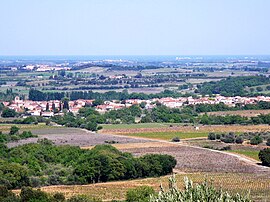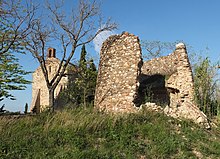Llupia
Llupià | |
|---|---|
 A general view of Llupia | |
| Coordinates: 42°37′18″N 2°46′11″E / 42.6217°N 2.7697°E | |
| Country | France |
| Region | Occitania |
| Department | Pyrénées-Orientales |
| Arrondissement | Perpignan |
| Canton | Les Aspres |
| Intercommunality | Perpignan Méditerranée Métropole |
| Government | |
| • Mayor (2020–2026) | Roger Rigall[1] |
| Area 1 | 6.88 km2 (2.66 sq mi) |
| Population (2021)[2] | 2,140 |
| • Density | 310/km2 (810/sq mi) |
| Time zone | UTC+01:00 (CET) |
| • Summer (DST) | UTC+02:00 (CEST) |
| INSEE/Postal code | 66101 /66300 |
| Elevation | 88–140 m (289–459 ft) (avg. 104 m or 341 ft) |
| 1 French Land Register data, which excludes lakes, ponds, glaciers > 1 km2 (0.386 sq mi or 247 acres) and river estuaries. | |
Llupia (French pronunciation: [jypja] ; Catalan: Llupià) is a commune in the Pyrénées-Orientales department in southern France.
Geography
[edit]Llupia is located in the canton of Les Aspres and in the arrondissement of Perpignan.

Toponymy
[edit]The historical name in Catalan is Llupià.
History
[edit]Government and politics
[edit]

Mayors
[edit]| Mayor | Term start | Term end |
|---|---|---|
| Roger Rigall | 2001 |
Population
[edit]| Year | Pop. | ±% p.a. |
|---|---|---|
| 1968 | 282 | — |
| 1975 | 399 | +5.08% |
| 1982 | 931 | +12.87% |
| 1990 | 1,253 | +3.78% |
| 1999 | 1,734 | +3.68% |
| 2007 | 1,820 | +0.61% |
| 2012 | 1,960 | +1.49% |
| 2017 | 1,943 | −0.17% |
| Source: INSEE[3] | ||
See also
[edit]References
[edit]- ^ "Répertoire national des élus: les maires" (in French). data.gouv.fr, Plateforme ouverte des données publiques françaises. 13 September 2022.
- ^ "Populations légales 2021" (in French). The National Institute of Statistics and Economic Studies. 28 December 2023.
- ^ Population en historique depuis 1968, INSEE




Well, that’s interesting to know that Psilotum nudum are known as whisk ferns. Psilotum nudum is the commoner species of the two. While the P. flaccidum is a rare species and is found in the tropical islands. Both the species are usually epiphytic in habit and grow upon tree ferns. These species may also be terrestrial and grow in humus or in the crevices of the rocks.
View the detailed Guide of Psilotum nudum: Detailed Study Of Psilotum Nudum (Whisk Fern), Classification, Anatomy, Reproduction